| |||||
| Decades: | |||||
|---|---|---|---|---|---|
| See also: | |||||
The following lists events that happened during 1946 in Jordan .
| |||||
| Decades: | |||||
|---|---|---|---|---|---|
| See also: | |||||
The following lists events that happened during 1946 in Jordan .

The history of Jordan refers to the history of the Hashemite Kingdom of Jordan and the background period of the Emirate of Transjordan under British protectorate as well as the general history of the region of Transjordan.

The Emirate of Transjordan, officially known as the Amirate of Trans-Jordan, was a British protectorate established on 11 April 1921, which remained as such until achieving formal independence in 1946.
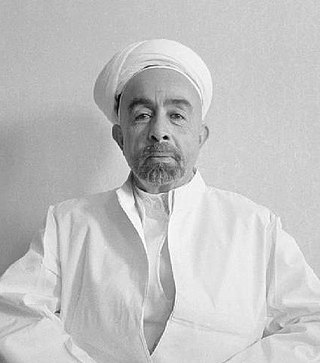
Abdullah I bin Al-Hussein was the ruler of Jordan from 11 April 1921 until his assassination in 1951. He was the Emir of Transjordan, a British protectorate, until 25 May 1946, after which he was king of an independent Jordan. As a member of the Hashemite dynasty, the royal family of Jordan since 1921, Abdullah was a 38th-generation direct descendant of Muhammad.

Talal bin Abdullah was King of Jordan from the assassination of his father, King Abdullah I, on 20 July 1951 until his forced abdication on 11 August 1952. As a member of the Hashemite dynasty, the royal family of Jordan since 1921, Talal was a 39th-generation direct descendant of Muhammad.

The coat of arms of Jordan or the Emblem of the Hashemite Kingdom of Jordan is the arms of dominion for the king of Jordan. The emblem was initially adopted by Abdullah I, the Emir of Transjordan, in 1921. The emblem continued to be used after Transjordan emerged as an independent kingdom in 1946.

Lieutenant-General Sir John Bagot Glubb, KCB, CMG, DSO, OBE, MC, KStJ, KPM, known as Glubb Pasha and Abu Hunaik by the Jordanians, was a British soldier, scholar, and author, who led and trained Transjordan's Arab Legion between 1939 and 1956 as its commanding general. During the First World War, he served in France. Glubb has been described as an "integral tool in the maintenance of British control."
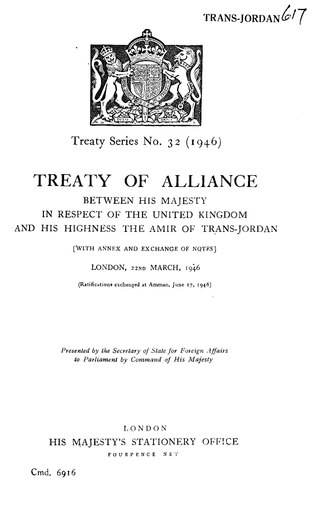
The Treaty of London was signed between the United Kingdom and the Emirate of Trans-Jordan on 22 March 1946 and came into force on 17 June 1946.
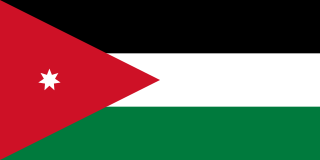
Jordan, officially the Hashemite Kingdom of Jordan, is a country in West Asia. It is situated at the crossroads of Asia, Africa, and Europe, within the Levant region, on the East Bank of the Jordan River. Jordan is bordered by Saudi Arabia to the south and east, Iraq to the northeast, Syria to the north, and the Palestinian West Bank and Israel to the west. The Dead Sea is located along its western border and the country has a 26 km (16 mi) coastline in its southwest on the Gulf of Aqaba's Red Sea, which separates Jordan from Egypt. Amman is Jordan's capital and largest city, as well as its economic, political, and cultural centre.
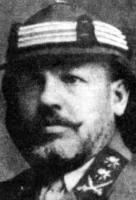
Ali Rida Pasha al-Rikabi was the First Prime Minister in modern Syria and was also the 3rd Prime Minister of Jordan.

Samir al-Rifai was Jordanian politician. He served several terms as the 8th Prime Minister of Jordan. He was born in Safed, Palestine.

This is a survey of the postage stamps and postal history of Jordan, formerly Transjordan.

Events in the year 1946 in Mandatory Palestine.
This is a timeline of major events in the history of the modern state of Jordan.

The All-Palestine Government was established on 22 September 1948, during the 1948 Arab–Israeli War, to govern the Egyptian-controlled territory in Gaza, which Egypt had on the same day declared as the All-Palestine Protectorate. It was confirmed by the Arab League and recognised by six of the then seven Arab League members, with Transjordan being the exception. Though it claimed jurisdiction over the whole of the former Mandatory Palestine, its effective jurisdiction was limited to the All-Palestine Protectorate (which came to be called the Gaza Strip. The President of the protectorate was Hajj Amin al-Husseini, former chairman of the Arab Higher Committee, and the Prime Minister was Ahmed Hilmi Pasha. The legislative body was the All-Palestine National Council.
The following lists events that happened during 1949 in Jordan.

Jordanian nationalism is a nationalistic ideology that considers the Jordanian people a part of a wider Arab Nation. It first emerged in 1920, when Muslim, Christian and Circassian tribes supported Emir Abdullah I in establishing the Emirate of Transjordan, later supporting Jordan's independence from British administration in 1946.
Baha ud-din Toukan was a Jordanian Ambassador.
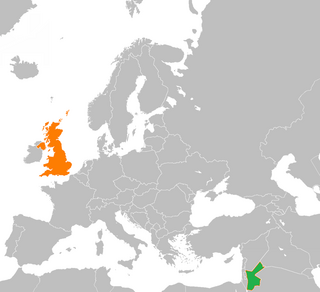
Anglo-Jordanian relations refers to the relationship between the Hashemite Kingdom of Jordan and the United Kingdom of Great Britain and Northern Ireland. Both countries share a relatively close relationship because of the Hashemites, who received British help to overthrow Ottoman rule in the country during World War I.
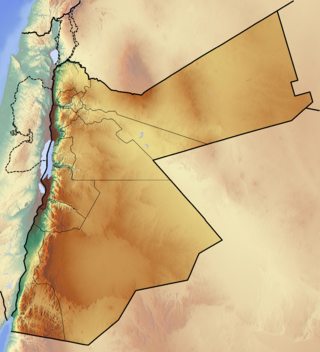
The Jordan–Saudi Arabia border is 731 km (454 mi) in length and runs from the Gulf of Aqaba in the south-west to the tripoint with Iraq in the north-east.